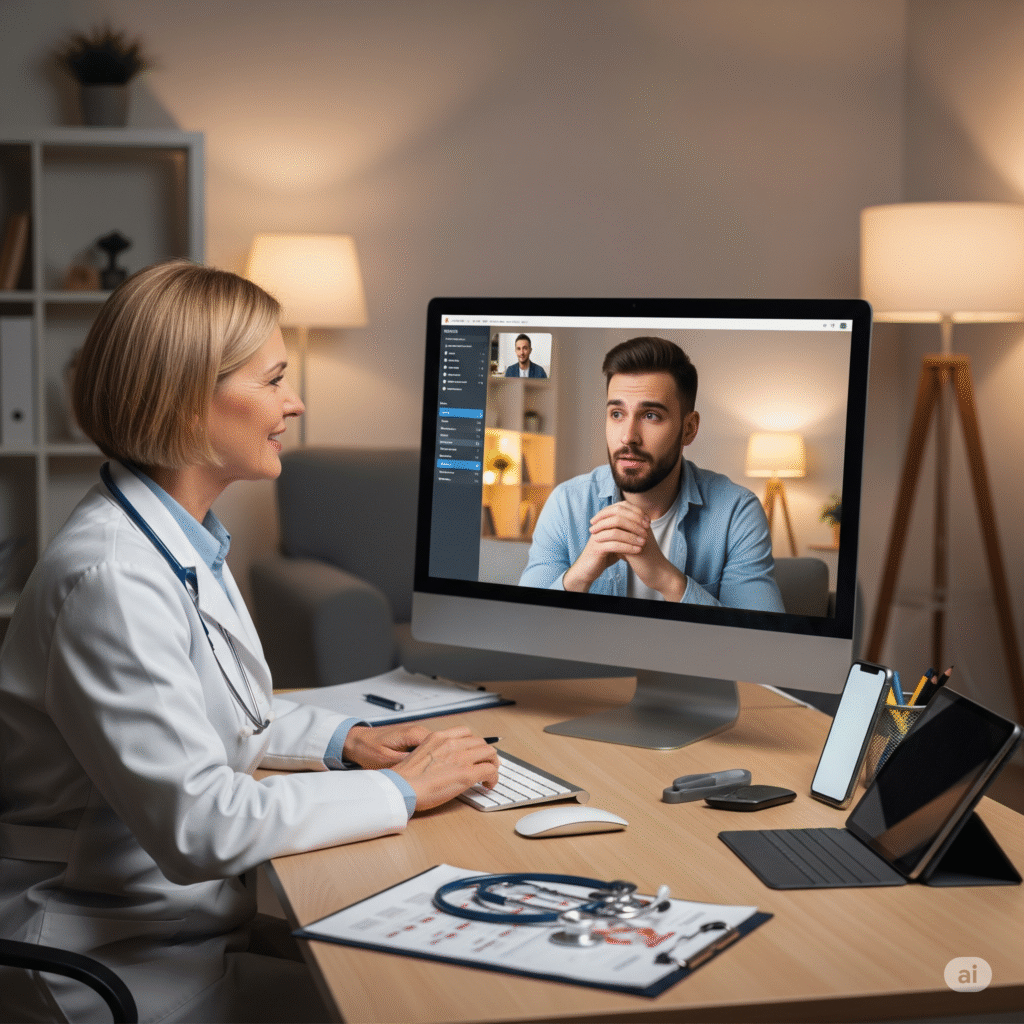Telemedicine: Bridging the Gap in Healthcare
Introduction
In an increasingly digital world, healthcare is no exception to the transformative power of technology. Telemedicine, once a niche concept, has rapidly evolved into a cornerstone of modern medical practice, fundamentally altering how patients access care and how healthcare providers deliver it. This article will delve into what telemedicine truly entails, explore its myriad benefits and inherent challenges, and cast a gaze into its promising future.
What Exactly Is Telemedicine?
At its core, telemedicine refers to the delivery of healthcare services and information using telecommunications technology. Think of it as your doctor’s office, but instead of a physical visit, you’re connecting via video call, phone, or even secure messaging. It’s a broad term that encompasses a variety of services, ranging from a quick consultation for a common cold to the remote monitoring of chronic conditions.
Historically, telemedicine emerged from the need to provide medical care to patients in remote or underserved areas, where access to specialists or even general practitioners was limited. However, the recent global health crises, most notably the COVID-19 pandemic, accelerated its adoption, pushing it into the mainstream and showcasing its indispensable role in maintaining continuity of care while minimizing physical contact.
The Unquestionable Benefits of Telemedicine
The rise of telemedicine isn’t just a technological fad; it’s driven by tangible benefits that improve healthcare accessibility, efficiency, and patient experience.
Enhanced Accessibility
Perhaps the most significant advantage is improved accessibility. For individuals living in rural areas, those with mobility issues, or patients who simply find it difficult to travel due to work or family commitments, telemedicine removes geographical and physical barriers. A specialist consultation, which might have required hours of travel and waiting, can now happen from the comfort of one’s home. This democratizes healthcare, ensuring that more people, regardless of their location or physical limitations, can receive timely medical attention.
Convenience and Time-Saving
In today’s fast-paced world, convenience is paramount. Telemedicine eliminates the need for commuting to clinics, finding parking, and enduring lengthy waiting room times. This translates to significant time savings for both patients and healthcare providers. A quick follow-up appointment or a prescription refill can be handled efficiently, freeing up valuable time for everyone involved. This not only reduces stress for patients but also allows doctors to manage their schedules more effectively.
Cost-Effectiveness
While the initial setup might require some investment, telemedicine can lead to cost savings in the long run. Patients save on transportation costs, parking fees, and potentially lost wages from taking time off work. For healthcare systems, it can optimize resource allocation, reduce overcrowding in emergency rooms for non-urgent cases, and lower overheads associated with maintaining large physical spaces.
Continuity of Care and Chronic Disease Management
Telemedicine is particularly effective for managing chronic diseases like diabetes, hypertension, or heart conditions. Patients can have regular check-ins with their doctors, monitor their vitals from home using connected devices, and receive immediate feedback. This consistent monitoring helps in early detection of issues, better adherence to treatment plans, and ultimately, improved health outcomes. It fosters a stronger, more continuous relationship between patient and provider.
Reduced Exposure to Illness
Especially relevant in times of epidemics or pandemics, telemedicine significantly reduces the risk of exposure to infectious diseases. Patients with contagious conditions can receive care without potentially spreading the illness to others in a waiting room, and vulnerable patients can avoid exposure to common illnesses present in healthcare settings.
Navigating the Challenges of Telemedicine
Despite its many advantages, telemedicine isn’t without its hurdles. Addressing these challenges is crucial for its sustainable growth and widespread acceptance.
Technological Barriers and Digital Divide
Not everyone has reliable internet access or the necessary digital literacy to engage with telemedicine platforms. The digital divide means that elderly populations, individuals in low-income communities, or those in truly remote areas might struggle to access these services. Ensuring equitable access requires robust infrastructure and digital education initiatives.
Privacy and Cybersecurity Concerns
As someone proficient in cybersecurity, you know this is a huge one. The transmission and storage of sensitive patient data electronically introduce significant privacy and cybersecurity risks. Protecting electronic health records (EHRs) from breaches, ensuring secure communication channels, and complying with stringent data protection regulations (like HIPAA in the US or GDPR in Europe) are paramount. A single data breach can erode patient trust and lead to severe legal repercussions. Robust encryption, multi-factor authentication, and continuous vulnerability assessments are essential.
Diagnostic Limitations
Certain medical conditions still require a physical examination for accurate diagnosis. A doctor cannot palpate an abdomen, listen to lung sounds with a stethoscope, or check reflexes over a video call. This limitation means telemedicine often works best for follow-ups, minor ailments, or initial screenings, with in-person visits still necessary for more complex or acute conditions.
Reimbursement and Regulatory Issues
The regulatory landscape for telemedicine is still evolving in many places. Questions surrounding licensing across state or national borders, malpractice liability, and consistent reimbursement policies from insurance providers can create complexity for both practitioners and patients. Clear and standardized regulations are vital for its widespread adoption.
Patient-Doctor Relationship Dynamics
Some argue that telemedicine can depersonalize the patient-doctor relationship. The human touch, empathy, and non-verbal cues that are often crucial in a traditional consultation might be diminished in a virtual setting. Building rapport and trust remotely requires conscious effort from both sides.
The Future is Now: What’s Next for Telemedicine?
The trajectory of telemedicine is undeniably upward, propelled by technological advancements and shifting patient expectations.
Integration with AI and Wearable Tech
The future will see even deeper integration with Artificial Intelligence (AI) and wearable technology. AI can assist in analyzing patient data from wearables (like smartwatches monitoring heart rate or glucose levels), flagging anomalies, and even helping with preliminary diagnoses. AI-powered chatbots can handle routine queries, freeing up doctors for more complex cases.
Remote Monitoring and Personalized Care
Remote patient monitoring (RPM) will become more sophisticated, allowing doctors to track vital signs, medication adherence, and activity levels in real-time. This data-driven approach will enable more personalized care, proactive interventions, and better management of chronic conditions, potentially preventing hospital readmissions.
Virtual Reality (VR) and Augmented Reality (AR)
Imagine a future where VR and AR enhance telemedicine. Surgeons could consult on complex cases using AR overlays of patient scans, or patients could experience immersive educational content about their conditions. While still nascent, these technologies hold immense potential.
Hybrid Models of Care
The most likely scenario is a hybrid model of care, where telemedicine complements traditional in-person visits rather than completely replacing them. Patients will have the flexibility to choose the most appropriate modality for their needs, ensuring a more efficient and patient-centric healthcare system.
Conclusion
Telemedicine is no longer just an alternative; it is an integral part of modern healthcare. While it presents challenges that require thoughtful solutions, its capacity to enhance accessibility, convenience, and continuity of care is undeniable. As technology continues to advance and regulatory frameworks mature, telemedicine is poised to transform the healthcare landscape, making quality medical attention more accessible and efficient for everyone, truly bringing the doctor just a click away.
© 2025 https://www.upcorehub.com . All rights reserved.


